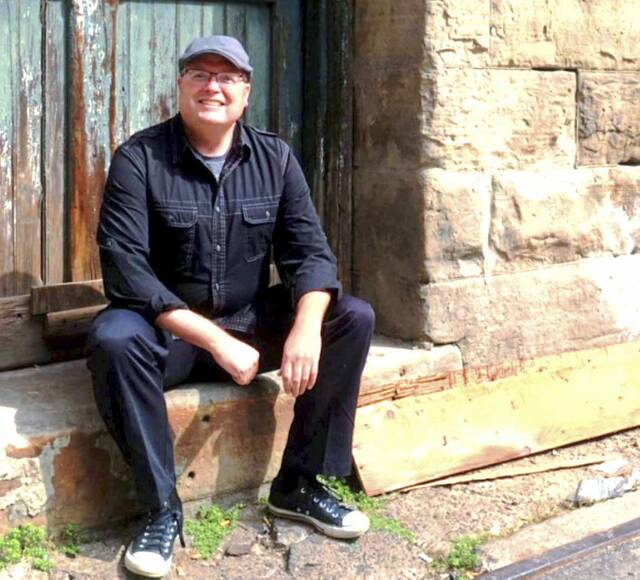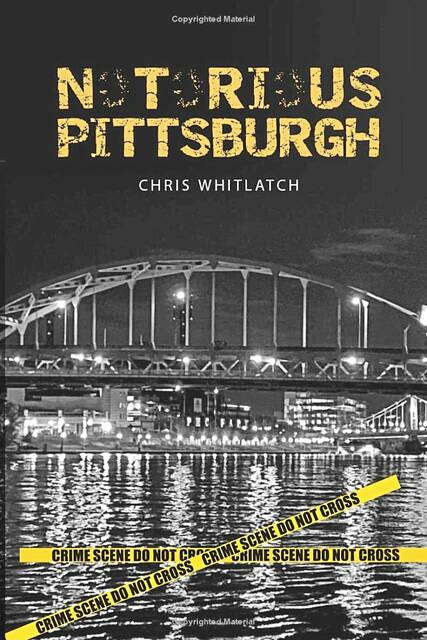‘Notorious Pittsburgh’: Book tells tales from city’s seedy underbelly
A man of questionable business practices fishes in his pocket for the key to his Cadillac, which is parked in a dark alley.
He probably hears the sound of approaching shoes as he attempts to enter the car. Soon, he is mortally wounded by four gunshots to the chest, shoulder and hip.
“That was definitely a professional hit and was never, never solved,” Chris Whitlatch said.
And rather than taking place in New York, Chicago or another city better known for bloodshed, the 1977 murder of George Lee took place outside of a Pittsburgh restaurant.
Whitlatch tells the stories of Lee and numerous other underworld figures in “Notorious Pittsburgh,” a book derived from his narratives during Downtown walking tours of the same name.
Readers will learn about a criminal element starting more than two centuries ago with the region’s first bank robbery, continuing into Prohibition and hitting a high — or more accurately, low — point with a flourishing red-light district in the 1960s and ’70s.
That part of Downtown, between Liberty and Penn avenues, today serves as the center of activity for the Pittsburgh Cultural Trust, which started acquiring property in 1984 and has cleaned up the area to the point where barely a trace of its sordid background remains.
“When I first started doing the walking tours, one of the buildings, the one where Arcade Comedy is in now, was still not done,” Whitlatch said. “And you could see faded out on the second-floor window, ‘Massage Parlor.’”
Like a Scorsese script
His interest in the history of what now is the Cultural District began with an assignment he received when he worked for the Pittsburgh Foundation, another nonprofit that strives to improve quality of life. Whitlatch was asked to research what the district’s buildings looked like before their makeovers.
“I ended up searching through newspaper archives after newspaper archives,” he said. “It read like a script that Martin Scorsese would have written. It was all ‘wise guys’ and the most normal people, too, that you wouldn’t expect being involved in this low-level crime.”
Lee, for example, was an ironworker by day who, when switching to his nightly pursuits, “kept his same dress of work boots and a work shirt, complete with a pocket protector,” Whitlatch wrote. “Not who you would picture as the premier sex peddler of Pittsburgh.”
Other names that once made headlines might have a slightly familiar ring, but more than likely they’re new to “Notorious Pittsburgh” readers: Mel Cummings, Nick DeLucia, Dante “Tex” Gill, Glenn and Sasha Scott, and “the Gentleman of Verona,” as Whitlatch titles the chapter about him, Michael Genovese.
Then there’s Richard Henkel, who pleaded guilty to crimes so heinous that the author refers to him as “the serial killer that most Pittsburghers don’t know.”
No Annie Hall
Included in the book is the story on which the 1984 movie “Mrs. Soffel,” starring Diane Keaton and Mel Gibson, is based. It seems that the wife of the Allegheny County Jail warden fell in love with one of the prisoners, and she helped him and his brother escape.
Photographs show Katherine Soffel as looking nothing like Annie Hall. In “Notorious Pittsburgh,” illustrator and Oakmont resident Joe Wos portrays her along the lines of contemporary descriptions, with sunken eyes and thin lips.
Regarding his caricature of George Lee, Whitlatch said he teases Wos about it being somewhat self-referential.
A native of Uniontown and current Cranberry Township resident, Whitlatch honed his writing talents by earning a degree in journalism from New York University. “Notorious Pittsburgh” represents his first long-form work.
“Even though these are short stories, it was a matter of, could I weave them together to actually finish a book?” he said. “I’ve had plenty of ideas, but this one never left. It was always pushing me to do the next thing, the next thing, and finish the book.”
He is in the midst of what he calls, with tongue in cheek, the Notorious Pittsburgh World Tour 2023. It does take him to libraries around the region, where he’s receiving plenty of support.
“I’ve met so many people who just have an interest in Pittsburgh history,” Whitlatch said. “And a lot of these stories just aren’t told in a regular setting.”
For example, a woman showed him newspaper clippings reporting a 1970s back robbery in which she was held hostage.
“That’s what happened on the walking tours, too,” he said about such revelations. “All of these people brought all of this firsthand knowledge to it.”
As for his book’s simple but enticing title:
“It gets people to at least take a look.”
For more information, visit www.notoriouspittsburgh.com.
Remove the ads from your TribLIVE reading experience but still support the journalists who create the content with TribLIVE Ad-Free.


